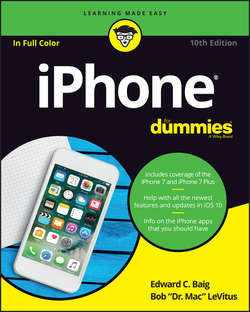Читать книгу iPhone For Dummies - LeVitus Bob - Страница 12
Part 1
Meet Your iPhone
Chapter 2
iPhone Basic Training
Locking the iPhone
ОглавлениеCarrying a naked cellphone in your pocket is asking for trouble. Unless the phone has some locking mechanism, you may inadvertently dial a phone number. Try explaining to your boss why he or she got a call from you during your 4 a.m. jog. Fortunately, Apple makes it a cinch to lock the iPhone so this pocket-dialing scenario won’t happen to you.
In fact, you don’t need to do anything to lock the iPhone; it happens automatically, as long as you don’t touch the screen for one minute. (You can change this duration in iPhone Settings, a topic in Chapter 14.)
Can’t wait? To lock the iPhone immediately, press the sleep/wake button. To unlock it, you can press the sleep/wake button again. Or press the Home button on the front of the screen. Either way, press the Home button again to open your phone, a change that arrived with iOS 10. Prior to iOS 10, the words Slide to Unlock appeared near the bottom of the screen and to unlock the device, you dragged your finger to the right and then, in some cases, also entered a passcode, another topic reserved for Chapter 14. If you set up the iPhone to use Touch ID, you can merely press your finger against the Home button to unlock it.
The iOS 10 software upgrade brought another feature to the most recent iPhones: the capability to wake up the screen merely by raising the phone. The raise-to-wake feature, which you can turn on or off inside Settings, requires an iPhone with an M9 coprocessor or later, which as of this writing means the iPhone 6s, 6s Plus, SE, 7, or 7 Plus. The 7 and 7 Plus have an Apple-designed A10 Fusion chip with an embedded M10 motion coprocessor.
The last few iterations of iOS software also brought refinements to Notification Center. In iOS 10, Apple separated Notification Center from the today view; we get to both later in this chapter. For now, know that you can view Notification Center by swiping down from the top of any screen. You can view the today view from the Lock or Home screen by swiping from the left. Worth noting: If you swipe from the right when on the Lock screen, you’ll summon the iPhone’s Camera app.
You can act upon notifications by swiping your finger or by taking advantage (on compatible models) of 3D Touch, which we also get to later in this chapter. We have more on the Lock screen in Chapter 9.
TRAINING YOUR DIGITS
We’ve already told you how to train your digits to use Touch ID. Well, your fingers play a prominent role throughout your iPhone experience, tapping, flicking, pinching, and dragging. Fortunately, these gestures are not challenging, so you’ll be mastering many of the iPhone’s features in no time:
● Tap: Tapping serves multiple purposes, as becomes evident throughout this book. You can tap an icon to open an app from the Home screen. Tap to start playing a song or to choose the photo album you want to look through. Sometimes you’ll double-tap (tapping twice in rapid succession), which has the effect of zooming in (or out) of web pages, maps, and emails.
● Flick: A flick of the finger on the screen itself lets you quickly scroll through lists of songs, emails, and picture thumbnails. Tap the screen to stop scrolling, or merely wait for the list to stop scrolling.
● Pinch/spread: On a web page or picture, pinch your fingers together to shrink the image, or spread your fingers apart to enlarge the image. Pinching and spreading (or what we call unpinching) are cool gestures that are easy to master and sure to wow an unfamiliar audience.
● Drag: Slowly press your finger against the touchscreen and then, without lifting your finger, move it. You might drag to move around a map that’s too large for the iPhone’s display area.
A gesture called reachability helps owners of the larger-display iPhones. By gently double-tapping (but not double-pressing) the Home button, the top portion of the screen shifts toward the bottom of the display so that you can tap icons and items that were previously out of reach. The purpose of this gesture is to help you use these phones with one hand.
A word about the Home button on the iPhone 7 and 7 Plus. Apple has replaced the traditional mechanical button with a solid-state pressure-sensitive button that provides haptic feedback when you press your finger against it. App developers can take advantage of the new button. And you can customize the click feel in Settings, which we recommend you play around with since it took us a little while to get used to this new iPhone landing spot.
